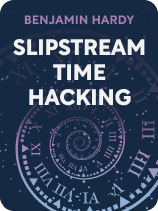

This article is an excerpt from the Shortform book guide to "Slipstream Time Hacking" by Benjamin Hardy. Shortform has the world's best summaries and analyses of books you should be reading.
Like this article? Sign up for a free trial here.
What’s Slipstream Time Hacking about? How much work could you get done if you had all the time in the world?
Organizational psychologist Benjamin Hardy writes in Slipstream Time Hacking that you can get the most out of any moment so you can experience more of life. You just need to move more quickly to make time run slower.
Read below for an overview of Slipstream Time Hacking.
Slipstream Time Hacking by Benjamin Hardy
There’s never enough time. Most of us spend our entire lives chasing deadlines and pursuing goals. We devote most of our waking hours to work, and it sometimes feels like we have little to show for it. Even worse, the best parts of life—like weekends with family and evenings with friends—never last long enough. But what if you could not only change how you spend your time but also alter how you experience the passage of time from day to day and year to year?
In Slipstream Time Hacking, Benjamin Hardy argues that fundamentally changing your experience of time is possible. He says that the key is to look at time as if it were distance. By focusing on how much ground you can cover and making your choices accordingly, you can practice a technique he calls “slipstream time hacking.” This method helps you make the most meaningful use of each moment: Hardy contends that if you speed up your progress toward your goals, you’ll effectively slow time down. Then you can reach the life you’ve envisioned for yourself sooner—and you’ll have more time to enjoy living it.
Hardy is an organizational psychologist, the writer of a popular blog on Medium, and the author of Willpower Doesn’t Work (2018), Personality Isn’t Permanent (2020), Be Your Future Self Now (2022), and The Gap and The Gain (2020) with Dan Sullivan. In Slipstream Time Hacking (2015), a book Hardy funded with a Kickstarter campaign as a Ph.D. student, he shares his method for fitting as much life as possible into your one human lifetime.
What’s Slipstream Time Hacking?
Hardy argues that you can get more out of your life if you take advantage of the relativity of time. He believes you can live the equivalent of many lifetimes in the years you have by using a technique called “slipstream time hacking.” The word “slipstream” refers to the force that makes it easier to travel faster right behind a fast-moving object. (We’ll discuss this in more detail later on.) “Time hacking” describes making radical changes to get the most out of your days and years. Put them together, and you get slipstream time hacking: a method for finding shortcuts that bring you to your goals in less time and with less effort than you would otherwise have to spend on achieving them.
To understand his method for making the most of your time on Earth, Hardy asks you to reframe how you think about time. An easy way to understand this is to consider how vast distances in outer space are measured in light-years: the distance that light travels in a year.
Imagine that you’re an astronaut planning a mission to a distant planet. You might take note of the distance between Earth and this distant planet in light-years, but your spaceship doesn’t travel at the speed of light. So even if the planet is only one light-year from Earth, it will take much longer than a year to get there. (If you’re borrowing a spacecraft from NASA, it could take 17,000 years!) Hardy contends that using slipstream time hacking is like traveling the distance from Earth to that remote planet at the speed of light instead of at the typical speed for your spaceship. You’re covering the same distance but doing it in much less time than would typically be possible.
In the same way that astronomers use light-years to describe vast distances in outer space, Hardy explains that you can think about the years of your life in terms of the distance you cover, rather than the time that elapses as you work toward your goals. For example, if you can find a way to write a novel in a single year—even though everyone’s told you it’ll take two or three years to get it done—you’ve found a way to cover more distance in that year, writing an entire book instead of just a third or a half of one. You’ve effectively slowed time down. As Hardy notes, that enables you to accomplish more in a finite amount of time and build a more meaningful life than one spent rushing around in pursuit of your goals.
Hardy explains that the idea of slipstream time hacking isn’t to speed up the process of achieving your goals so that you can set and achieve even more goals. It’s the opposite: He contends that you must focus on just a few of your most meaningful priorities to live the most meaningful life. That doesn’t mean that he wants you to think small. Rather, he contends that your dreams should be so big that they require help from forces—like relativity, time dilation, slipstreams, and wormholes—that would sound right at home in the most imaginative work of science fiction. Let’s examine these principles to see how they make slipstream time hacking possible.
Relativity
The first principle of slipstream time hacking is the relativity of time: the idea, stated by Albert Einstein, that time isn’t as objective as it seems. Instead, it depends on your frame of reference.
To wrap your head around how the relativity of time works, picture two astronauts, Audrey and David. Audrey goes to space and travels at the speed of light, while David stays on Earth. From David’s perspective, Audrey’s journey lasts many years. However, due to the high speed of her travel, time slows down for Audrey. When she returns to Earth, she feels only about a year older. So she’s surprised to see that David has aged dramatically. This is the relativity of time: the idea that time can speed up or slow down depending on an observer’s speed.
There are only 24 hours in a day. But Hardy writes that by taking advantage of the relativity of time, you can find more time each day to do the things that make you happy. This works because when you change the speed at which you’re traveling toward your goals, you also change how you perceive time. The rate at which time seems to pass depends entirely on your frame of reference as you’re experiencing it, just like for the astronauts in our example.
Time Dilation
The second principle of slipstream time hacking is that time slows as you move more quickly, as the principle of relativity suggests. This phenomenon is called time dilation. Hardy adopts the concept to explain how making faster progress toward your destination can feel like buying yourself more time to do something meaningful.
Hardy contends that you can use time dilation to your advantage. Let’s say you’re racing against a deadline to finish a difficult project at work. At first, you feel stressed by the number of hours you have: Each one feels insufficient as you try to figure out how to get the work done. But as you make progress, your pace speeds up and time seems to stretch. Each hour starts to feel productive, and the minutes pass more slowly. In other words, the more quickly you move, the more time seems to slow—and the more time you seem to have to complete the project.
Slipstream
A third principle crucial to Hardy’s method is that a force called slipstream makes it easier for you to travel quickly if you follow in someone else’s wake. In science fiction, the term “slipstream” describes traveling through space at speeds faster than light. But in basic physics, a slipstream refers to the current of air or water driven backward by a fast-moving object, like a marathon runner. When another runner follows behind the first runner, they can travel just as rapidly as the first—without expending as much energy to counter the wind resistance and maintain their speed as they’d have to if they were running alone.
Hardy explains that when you enter someone else’s slipstream, you experience a big change in velocity. (In other words, your speed increases very quickly.) He warns that this can feel uncomfortable in the moment. But following the time, money, skill, or energy other people have invested into accomplishing something gets you to your destination more quickly. By jumping in at their velocity, you can go farther (and at faster speeds) than you would if you had to build your own momentum. When you’re in someone’s slipstream, you’re following a shortcut and benefiting from what they’ve learned and accomplished.
To visualize how this might work, imagine that you’re an aspiring chef and want to open your own restaurant. So you apprentice with an award-winning chef you’ve admired for years. In her kitchen, you observe her, learn her methods, and get introduced to her colleagues and investors. By following in her slipstream—a force created by her experience, knowledge, and influence—you make significantly faster progress toward your goals than you would alone.
Wormholes
A fourth principle of Hardy’s method is that you can use wormholes to take shortcuts that reduce the time and effort needed to reach your goal. Hardy defines a “wormhole” as a shortcut that gets you to your goal in a nonlinear way. Importantly, not only does a wormhole enable you to spend less time traveling to your destination, but it also enables you to expend less effort getting there. Wormholes, as physicists define them, are theoretical. They’re thought to serve as a shortcut between two points in space separated by extremely long distances (like two locations on opposite sides of the galaxy). So finding a wormhole and traveling through it enables you to make incredible leaps toward your goals by reducing the distance you need to travel to get where you want to go.
Hardy considers traveling through wormholes an essential strategy for accomplishing big things. He believes that for most goals, you can find a wormhole that will change your life instantaneously. While finding wormholes comes down to luck, Hardy argues that you can create this luck by seeking it out. One way to do this is to travel in faster slipstreams, where you’re more likely to encounter a wormhole.
For example, let’s say you’re a writer who’s been struggling for years, writing and rewriting your novel and pitching it to dozens of agents with no luck. Then, you decide to go to a publishing industry conference, and at a party, you meet a literary agent who loves the idea of your book, has been looking for something just like it, and wants to read the manuscript. That unexpected connection presents a wormhole: an opportunity that could dramatically shorten the path between you and your goal of publishing your novel.
Why Is All of This Important?
Relativity, time dilation, slipstream, wormholes: That’s a lot of physics (or science fiction) to wrap your head around. Hardy explains that time hacking involves using all these principles to make the most of your time. People “hack” their bodies, work, or productivity when they use out-of-the-ordinary methods to achieve extraordinary results. So Hardy uses the word “time hacking” to refer to radically slowing time down so that you can accomplish much more in your life than you’d achieve if you proceeded more conventionally.
Hardy explains that time hacking requires you to recognize that you’re in control of your time and to seek out slipstreams and wormholes that will speed your progress toward your goals. To engage in time hacking, you can’t think of time as linear, but instead have to think of it as nonlinear: a medium you can traverse at much faster speeds than you’ve ever thought possible. By taking advantage of the relativity of time and leveraging slipstreams and wormholes to take shortcuts, you can get more—more meaning, more happiness, and more progress toward your most important goals—out of the time you have.
How Can You Actually Slow Time Down?
Unlike wormholes and time travel, slipstream time hacking isn’t just theoretical. Instead, Hardy explains that it’s a practical method to achieve your goals. In this section, we’ll consider the practical steps he recommends for slowing time down. Hardy contends that when you put his method to work, you can speed up your progress toward your most important goals and spend more time living the life you’ve always wanted.
Zero in on Your Core Values and Goals
Hardy writes that the first step to slowing time is to make choices that align with your values and move you closer to the goals that matter most. That requires gaining a clear understanding of what you value and want most in your life. When you start to think about your days in terms of the distances you can travel rather than the hours you can fill, you can more easily determine how it would be most meaningful to use your time.
For example, you might realize that one of your core values is spending time with your family and think about how frequently (or infrequently) you see your parents. You can do the “depressing math” to determine how much time you’ll likely spend with them if you continue to see them at your current rate. If you don’t like the results, you can choose to see them more often. You’re still looking at the same amount of time passing, but you’re figuring out how to use that time to do something you value: spending time with your family.
Hardy recommends identifying which of your goals are most important to you and putting aside everything else, including work that you find unsatisfying or tasks that you consider unfulfilling. You might need to put aside things that seem meaningful or fulfilling, too: Hardy contends that if you have more than three major goals, you need to narrow your focus. While this requires foregoing some opportunities, that’s a necessary part of pursuing your most important goals. Once you’ve identified your vision for your life, Hardy recommends committing to it wholeheartedly. But along the way, you shouldn’t be afraid to course-correct to keep yourself on track toward your goals.
Find Other People Moving in the Same Direction You’re Going
A second strategy to speed up your progress toward your goals is to find other people you can learn from and travel alongside. Hardy explains that this might involve finding a mentor or joining a group of people working to achieve goals that are similar to yours. You can enter the slipstream of these individuals or groups and look for wormholes along the way.
Traveling alongside people who are slowing time can also be helpful because not everyone will understand what you’re doing. Hardy notes that when you use slipstream time hacking, you’re departing from the status quo and acquiring knowledge or experiencing change at a pace that might feel unfamiliar to others in your life. Some people who don’t understand what you’re doing might try to discourage you. For example, people in Picasso’s time didn’t understand what he was doing in his paintings. But by developing Cubism, he pushed art forward at an incredible speed—even if people didn’t like how his paintings demanded that they look at art in a new way.
Hardy recommends that as you find your path, you should also seek out ways to help other people slow down time, too. He explains that the goal should be for everybody to slow time and live more meaningful lives as individuals and as a community. If we all work together, everyone can learn to slow time in their own lives. You can help others toward that goal by using your skills in slipstream time hacking.
Set Up Your Day to Help You Slow Down
A third step you can take to practice slipstream time hacking is to structure your days around the goal of slowing time. Hardy writes that many people hurry through their lives and spend their days rushing toward deadlines or goals. By letting this process consume their time and attention, they speed up their time rather than slowing it down. But you can avoid this pitfall by cultivating habits that slow time down every day.

———End of Preview———
Like what you just read? Read the rest of the world's best book summary and analysis of Benjamin Hardy's "Slipstream Time Hacking" at Shortform.
Here's what you'll find in our full Slipstream Time Hacking summary:
- That your far-off goals might be closer than you think
- How to buy more time by making time run slower
- Why you might want to apply Einstein’s theory of relativity to your life






